Biodegradable plastics are considered to be the solution to the plastic pollution problem. They are polymers that can be mineralized by microorganisms into water, carbon dioxide, methane and biomass. Bioplastics are made from renewable natural polymers derived from plants such as cassava, corn and potato starch or from bacteria such as poly (3-hydroxyalkanoate). It should be noted that not all bioplastics are biodegradable, and likewise, not all biodegradable plastics are made from renewable natural resources.
Another type of biodegradable plastic is made by adding metal salt additives to petroleum-based plastics, such as low density polyethylene (LDPE), often referred to as oxygen biodegradable plastics. Metal salts act as pro-oxidants, initiating the photo- or thermal oxidation of long-chain polyethylene polymers and breaking them down into lower molecular weight fragments that may be more susceptible to microbial attack. However, the biodegradability of carbonyl biodegradable plastics has been much debated as to whether they actually break down into simpler molecules (oxidatively degradable) or just into microplastic fragments. Despite the controversial nature and the EU Parliament's ban on the use of oxo-degradable plastics, oxidized LDPE is one of the main types of plastics on the Indonesian market that claim to be biodegradable and environmentally friendly.
Plastic pollution has been one of the major ecological problems of the last decades. New generations of plastics that degrade more easily in the environment than traditional plastics, such as starch-based bioplastics and oxo-biodegradable plastics, are considered to be the solution to this problem. However, the impact of degradation products of these materials in the environment on soil microbial communities is unknown, and little is known about how their presence affects microorganisms that may play a role in their biodegradation.
Recently, in this study, a team of researchers from the Catholic University of Atma Jaya, Indonesia, monitored the dynamics of bacterial communities in soil when introducing commercial carrier bags that claim to be biodegradable: cassava starch-based bioplastics and carbonyl low-density polyethylene (oxo-LDPE). Plastic bags of each type were buried in composted soil and incubated for 30, 60, 90 and 120 days. After incubation, soil pH and temperature were measured as well as the weight of the remaining plastic. Analysis of bacterial diversity in soil attached to remaining plastic surfaces using Illumina high-throughput sequencing of the V3-V4 region of the 16SrRNA gene.
After 30 days, the weight of cassava starch-based bioplastics was reduced by 56%. Subsequent weight loss was less dramatic, with 61%, 69% and 74% weight loss on days 60, 90 and 120, respectively (Figure 1). This is consistent with a previous study that showed only 1-1.5% degradation after 120 days of burial in soil, even when combined with photo-oxidation pretreatment. UV irradiation induces oxidative cleavage of polyethylene chains in carbonyl-LDPE to produce lower molecular weight monomers or oligomers, so this treatment may also contribute to a 3% weight reduction. Overall, our results confirm that not all plastics that claim to be "biodegradable" degrade at the same rate in soil.
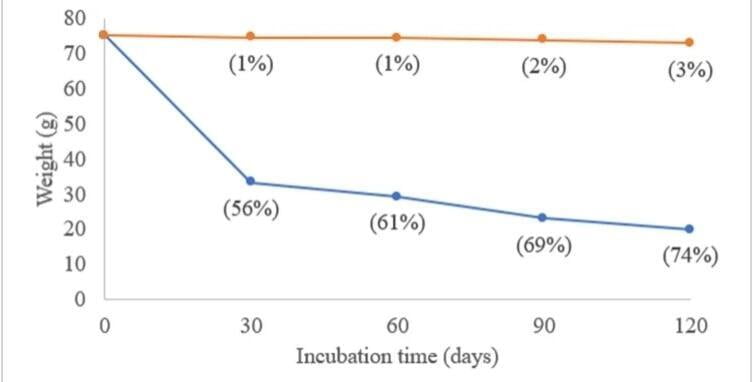
Weight reduction of starch-based bioplastics (blue) and oxy-LDPE (orange) after burial in composted soil for more than 120 days. The numbers in parentheses indicate the percentage weight reduction. The data shown are based on an experiment
2.1 Introduction of cassava starch-based bioplastics into composted soil bacterial communities
Vibrio heterotrophicus has been reported to coexist and communicate with Streptococcus gordonii during the early formation of dental plaque biofilms. This study shows that the presence of Vibrio saprophyticus increases the expression of the amylase-encoding gene amyB in Streptococcus gordonii. Aggregates of Mycobacterium mossum have been reported to grow on starch, glucose and maltose media. Although no amylase activity has been reported in B. mossambicus, B. mossambicus can use starch degradation products, such as maltose and glucose produced by starch-degrading bacteria.
Overall, this suggests that even though the aforementioned bacterial genera may not be directly involved in starch-based bioplastic degradation, they may thrive in soil through the use of starch degradation intermediates or through other interactions within the bacterial community.
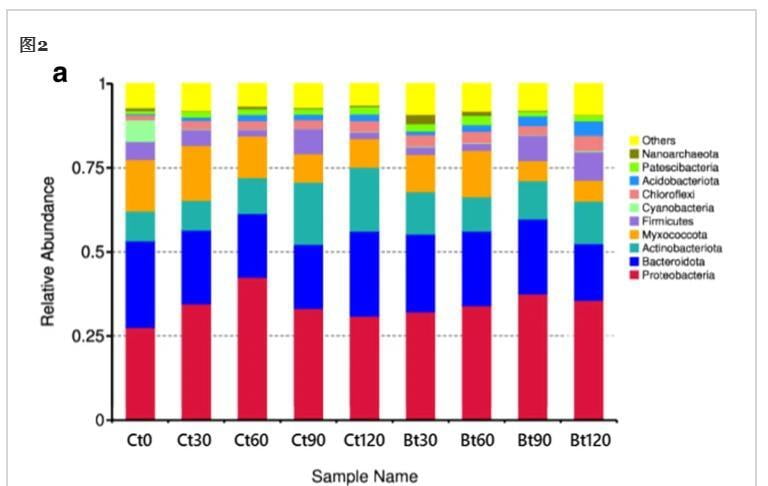
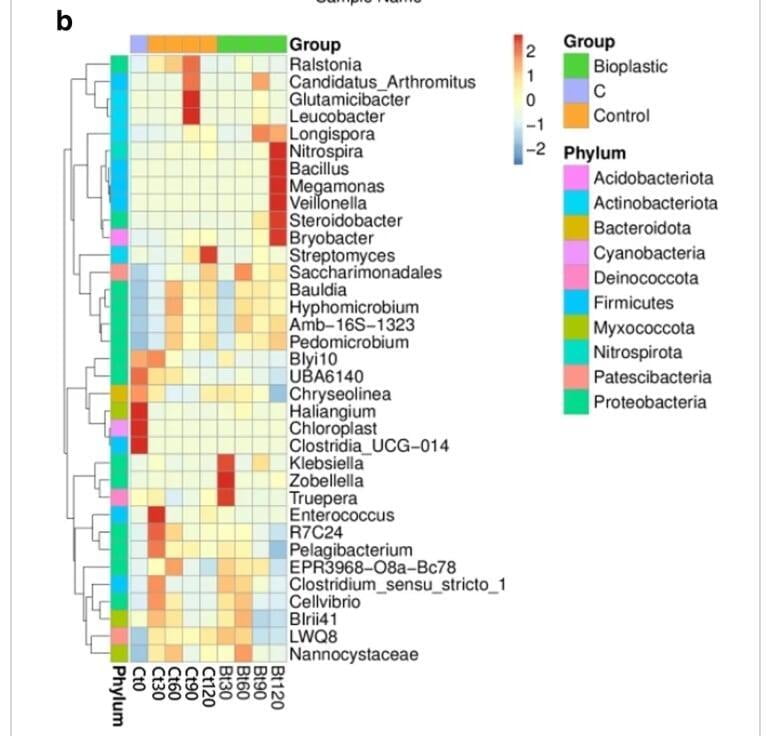
Abundance of bacterial phylum (a) and genus (b) in soil after starch-based bioplastic (Bt) burial compared to control soil without added plastic (Ct). The numbers following the example codes indicate the length of plastic burial (in days). Each bacterial phylum is indicated by a specific color
2.2 Bacterial communities in composted soil with the introduction of oxygen-LDPE
Similar to the observations for the starch-based bioplastic treatment, glycophytes were detected in the microplastic-contaminated soil (day 60). Similarly, Rheinhemera (day 90) was reported to be abundant in microplastic-infected water. Pantoea were found in the intestine of polyethylene-degraded Galleria mellonella and Tenebrio molitor larvae preserved in a polyethylene-rich diet (day 120). Portibacter was found among the main bacterial colonizers of polyethylene plastic fragments (day 90 and 120). Interestingly, as observed in starch-based bioplastics, no bacteria persistently multiplied at all time points in the soil where carbonyl LDPE was introduced. This suggests that starch-based bioplastics and carbonyl LDPE degradation may require a variety of bacteria that will continue to change over time.
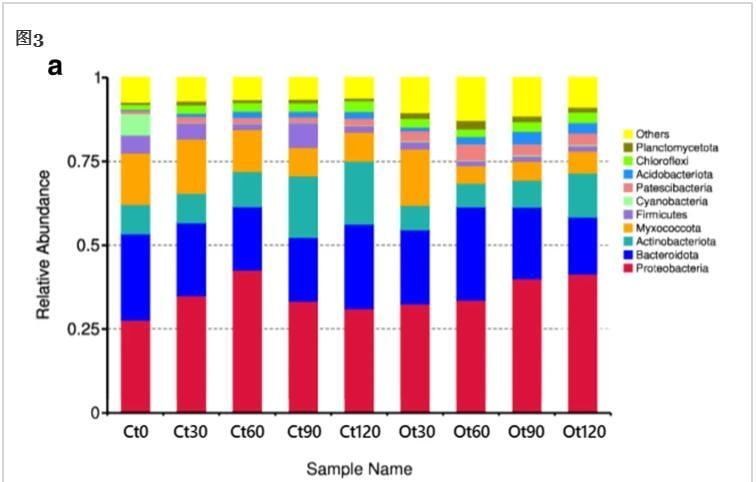
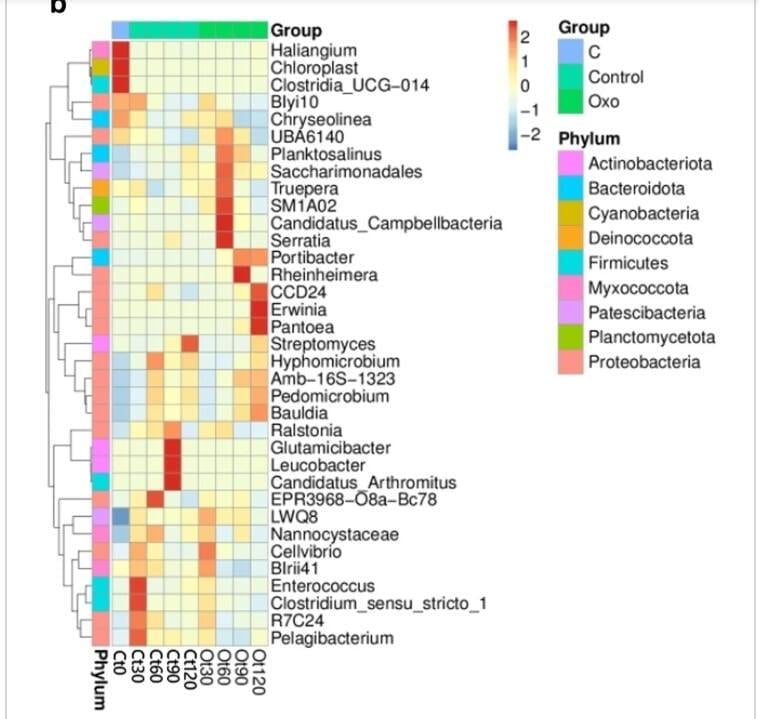
Abundance of soil bacterial phylum (a) and genus (b) after carbonyl-LDPE (Ct) burial compared to control soil without plastic (Ct) addition. The numbers following the example codes indicate the length of plastic burial (in days). Each bacterial phylum is indicated by a specific color
Tapioca starch-based bioplastics degrade faster in soil compared to carbonyl LDPE. Our results show that the bacterial composition of the soil changes over time, with or without the introduction of any type of plastic. Although the major bacterial phyla remained similar for all treatments in this study, the addition of the two types of plastics resulted in different shifts in the soil bacterial community. Different genera emerged at different time points, and no single genus continuously dominated the soil bacterial community. They represent bacteria that may be directly involved in the breakdown of plastic polymers, as well as bacteria that survive by interacting with degraders. Bacterial populations involved in the nitrogen cycle also emerged over time. Overall, this study suggests that the outcome of biodegradable plastics in the environment is determined by a complex set of microorganisms that evolve over time.

